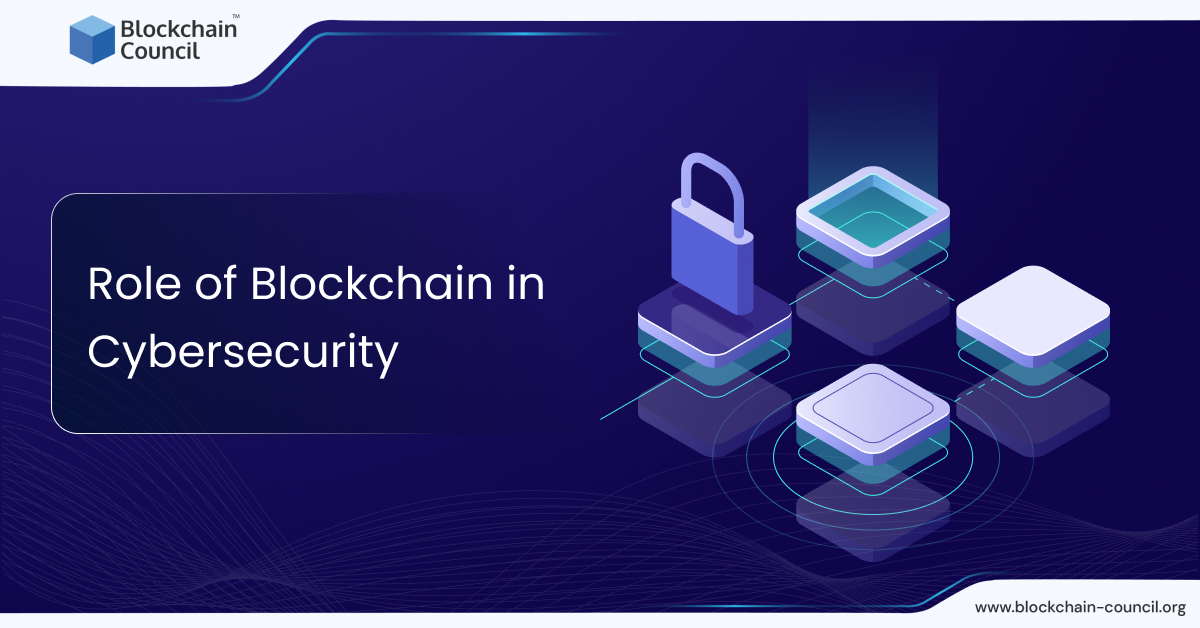
- Blockchain Council
- July 20, 2024
Blockchain Cybersecurity
- Blockchain and cybersecurity work together to protect sensitive data and digital assets in our digital age.
- Blockchain ensures data integrity through cryptographic techniques.
- Data in a Blockchain network is stored across multiple computers (nodes) in an immutable ledger.
- Cybersecurity is crucial for safeguarding sensitive information and preserving trust in digital interactions.
- Blockchain is a decentralized ledger technology for recording transactions.
- Smart contracts in Blockchain automate actions based on predefined rules, enhancing automation.
- The ledger in Blockchain is decentralized, eliminating the risk of data manipulation.
- Cryptography is used in Blockchain to secure data and transactions.
- Decentralization in Blockchain enhances cybersecurity by making it challenging for attackers to compromise the network.
- DDoS attacks are a formidable cybersecurity threat that can disrupt online services.
- Blockchain in cybersecurity opens doors to new horizons of securing our digital existence.
Blockchain in Security
In today’s digital age, cybersecurity is paramount. With cyber threats constantly evolving, protecting sensitive data and digital assets has become a top priority for individuals and organizations alike. Blockchain and cybersecurity are two pillars of modern digital technology, working hand in hand to secure our digital world. It is a decentralized ledger technology ensuring data integrity through cryptographic techniques. Cybersecurity, on the other hand, is the practice of protecting systems, networks, and data from digital threats and attacks. But what is the role of Blockchain in cybersecurity? In this article, we will have an in-depth look at how Blockchain technology can enhance cybersecurity!
Why Should You Consider Blockchain in Cybersecurity?
In the digital age, where data is invaluable, the intersection of Blockchain and cybersecurity is of paramount importance. Blockchain offers transparency, immutability, and enhanced security, making it a powerful ally in the fight against cyber threats. In a Blockchain network, data is stored across a network of computers (nodes) rather than on a single central server. Each block in the chain is linked to the previous one through cryptographic hashes, forming a secure and immutable ledger. Once data is added to the Blockchain, it cannot be altered or deleted without consensus from the majority of participants in the network.
In our interconnected digital world, cybersecurity plays a paramount role in safeguarding sensitive information. Every day, countless transactions, communications, and data transfers occur online, making security a critical concern. Cybersecurity is not merely a matter of protecting data; it’s about preserving trust in our digital interactions. The Role of Blockchain in Cybersecurity is a compelling narrative that delves into how this technology is transforming our digital defense mechanisms.
Understanding the Basics of Blockchain
How Blockchain Works
| Aspect | Description |
| Definition | A decentralized, distributed ledger technology for recording transactions across a network of computers. |
| Blocks and Chain | Data is stored in “blocks” sequentially linked to form a “chain”, creating an immutable record of transactions. |
| Decentralization | Multiple computers (nodes) maintain the network, eliminating the need for a central authority, enhancing security and transparency. |
| Transactions | Transactions are bundled into blocks, verified through consensus mechanisms, and added to the chain, ensuring validity and integrity. |
| Consensus Mechanisms | Algorithms like Proof of Work (PoW) or Proof of Stake (PoS) validate transactions, ensuring agreement among network participants. |
| Security and Immutability | Data stored in blocks is encrypted and linked, making it secure and tamper-resistant, enhancing trust and reliability of the system. |
| Smart Contracts | Self-executing contracts with predefined rules and conditions, automatically executing actions when criteria are met, enhancing automation. |
Key Components of a Blockchain
The Ledger:
Blockchain’s core component, the ledger, is an immutable, decentralized digital record of all transactions. It stores data in a series of blocks, each connected to the previous one, creating a chain. Transparency and security are ensured as every transaction is time-stamped and cryptographically linked. This ledger is distributed across multiple nodes, eliminating the need for a central authority. By doing so, Blockchain enhances cybersecurity by reducing the risk of data manipulation or unauthorized access. The ledger is the foundation upon which Blockchain’s security and trustworthiness are built.
Cryptography:
Blockchain uses advanced cryptographic techniques to secure data and transactions. Each participant in the network has a unique private key, and transactions are signed with it. Public keys, on the other hand, allow for transparency as they verify the authenticity of the sender. This robust encryption makes it extremely difficult for malicious actors to tamper with the data. Cryptography is the guardian of data integrity within the Blockchain, a vital aspect of cybersecurity.
Decentralization:
Decentralization is at the core of Blockchain’s transformative power in cybersecurity. Data is stored across multiple nodes, and no central authority has control over the entire network. Decentralization enhances cybersecurity by making it incredibly challenging for attackers to compromise the network. Even if one node is compromised, the rest of the network remains secure, ensuring data integrity.
Smart Contracts:
Smart contracts are the digital backbone of Blockchain technology, revolutionizing how agreements are executed and enforced. These self-executing contracts automate processes and transactions based on predefined rules without the need for intermediaries. Smart contracts operate on a “code is law” principle, ensuring transparency and trust among parties. They execute actions automatically when predetermined conditions are met, reducing the potential for disputes and fraud. Immutable and secure, smart contracts are tamper-proof once deployed on the Blockchain. They’re stored across multiple nodes, making them highly resilient to cyberattacks.
Also Read- What Are Blockchain Nodes? Detailed Guide
Blockchain vs. Traditional Database
To understand the role of Blockchain in cybersecurity, you must understand the difference between Blockchain and traditional databases:
| Aspect | Blockchain | Traditional Database |
| Data Storage | Decentralized ledger | Centralized server-based storage |
| Security | High due to cryptographic methods | Vulnerable to hacking and breaches |
| Data Integrity | Immutable once recorded | Subject to data manipulation |
| Data Access Control | Distributed control | Centralized access control |
| Trust and Transparency | High trust, transparent | Limited trust, less transparency |
| Consensus Mechanism | Various (e.g., PoW, PoS) | Typically, SQL-based transactions |
| Scalability | Scalability challenges | Scalable, but with limits |
| Maintenance and Control | Distributed, less centralized | Centralized maintenance and control |
Cybersecurity Threats
Common Cybersecurity Threats
Malware Attacks:
In today’s digital landscape, cybersecurity threats loom ominously, and among them, “Malware Attacks” stand as a formidable adversary. Malicious software, or malware, encompasses a broad category of digital threats designed to infiltrate, damage, or steal from computer systems. These insidious programs can take many forms, from viruses and worms to Trojans and ransomware. Malware attacks exploit vulnerabilities in a system’s security, often through deceptive email attachments or compromised websites. Once inside, they can wreak havoc by corrupting files, exfiltrating sensitive data, or even rendering a system inoperable. These attacks are relentless and adaptive, continuously evolving to evade detection by traditional antivirus software and security measures.
Phishing:
Phishing, a devious tactic, tricks individuals into divulging sensitive information. It often arrives disguised as legitimate emails or websites, exploiting human trust.
Cybercriminals craft convincing messages, imitating trusted entities, making it challenging to discern authenticity. These messages typically contain urgent requests, sparking fear or curiosity. Once users click on deceptive links or provide personal data, cybercriminals gain unauthorized access. This information becomes a valuable asset for future attacks or identity theft. Phishing attacks can lead to severe consequences, including financial losses and data breaches.
As technology evolves, phishing techniques become more sophisticated, demanding robust defences. Blockchain technology can play a pivotal role in combating phishing. Its decentralized and immutable ledger enhances email security. It can validate sender authenticity and prevent tampering with email content.
DDoS Attacks:
Distributed Denial of Service (DDoS) attacks are formidable adversaries in the realm of cybersecurity. These attacks inundate websites or online services with an overwhelming flood of traffic. The objective is to render the target inaccessible to legitimate users, causing disruptions and potentially substantial financial losses. DDoS attacks occur when a network of compromised devices, often referred to as a botnet, floods a target server with a deluge of data requests. This surge in traffic saturates the server’s resources, rendering it incapable of responding to genuine user requests.
The consequences of DDoS attacks can be devastating. They disrupt business operations, causing financial losses and damaging reputations. Additionally, they can serve as a smokescreen for other cyberattacks, making detection and response more challenging.
Also Read- The Ultimate Guide To Blockchain Engineer
The Intersection of Blockchain and Cybersecurity
| How Blockchain Addresses Security Concerns | Case Studies |
| Immutability and Data Integrity | Guardtime’s KSI uses Blockchain to ensure data integrity and immutability, securing critical systems such as Estonia’s e-government. |
| Digital Identities | Evernym uses Blockchain to secure digital identities, allowing users to control and manage their identity data securely. |
| Decentralization and Resilience | A joint venture leveraging Blockchain to enhance supply chain security, providing a tamper-proof record of transactions. |
| Security and Privacy | Microsoft employs Blockchain to enhance security and privacy across various industries, including healthcare and financial services. |
| Enhanced Authentication and Access Control | CyberVein employs Blockchain for secure data storage and sharing, ensuring data privacy and access control. |
| Secure cryptography techniques | Crystal uses Blockchain analytics to trace and track cryptocurrency transactions for compliance and cybersecurity purposes. |
Also Read- What Is XRP Ledger (XRPL)? How Does It Work?
Benefits of Integrating Blockchain into Cybersecurity
Enhanced Data Security
Blockchain achieves this through cryptographic techniques, creating a virtually tamper-proof ledger. Once data is recorded on a Blockchain, it becomes resistant to alteration, ensuring data integrity. Traditional centralized databases are vulnerable to hacks and breaches, as a single point of failure can compromise the entire system. However, Blockchain operates on a decentralized network of nodes, making it incredibly resilient to attacks. Each transaction is verified and recorded across multiple nodes, making it nearly impossible for an attacker to manipulate data. Moreover, Blockchain’s consensus mechanisms, like Proof of Work (PoW) and Proof of Stake (PoS), further strengthen data security.
Streamlined Identity Verification
In today’s digital world, identity verification is crucial for secure online transactions and interactions. However, traditional methods often fall short, leading to identity theft and fraud. This is where Blockchain technology steps in. Blockchain offers a streamlined approach to identity verification by creating a decentralized ledger of identity information. Instead of relying on a single, vulnerable database, identity data is distributed across a network of nodes. Each user retains control over their identity, with cryptographic keys ensuring secure access. This eliminates the need for a central authority, reducing the risk of data breaches or unauthorized access.
Transparency and Accountability
Transparency is a cornerstone of Blockchain technology. All transactions and data stored on the Blockchain are visible to authorized parties, creating a transparent and auditable system. This transparency is particularly valuable in supply chain management and financial transactions. In supply chain management, Blockchain can provide end-to-end visibility, allowing stakeholders to trace the origin and journey of products. This not only reduces the risk of counterfeits but also ensures the authenticity of goods.
In financial transactions, Blockchain’s transparency minimizes fraud and errors. Transactions are recorded in a public ledger accessible to all authorized parties, eliminating disputes and ensuring accountability.
Challenges of Blockchain in Cybersecurity
There are a number of challenges that we must overcome while implementing Blockchain in cybersecurity:
| Challenge | Description |
| Scalability | Blockchain networks can struggle to handle high transaction volumes, leading to delays and increased costs. This is a significant issue for real-time cybersecurity applications. |
| Interoperability | Integration of Blockchain with existing cybersecurity systems and protocols can be complex, potentially causing compatibility issues and hindering adoption. |
| Privacy and Confidentiality | While Blockchain provides transparency, ensuring privacy and confidentiality of sensitive cybersecurity data can be challenging. |
| Regulatory Compliance | Navigating evolving regulations and compliance requirements in different regions can pose legal and operational challenges for Blockchain-based cybersecurity solutions. |
| Energy Consumption | Proof-of-work Blockchains, like Bitcoin, can consume vast amounts of energy, raising environmental concerns and operational costs. |
| Key Management and Recovery | Safeguarding cryptographic keys used in Blockchain-based security systems and devising recovery mechanisms in case of loss or compromise is crucial yet intricate. |
| Governance and Consensus Mechanisms | Establishing effective governance and consensus mechanisms within decentralized Blockchain networks can be a governance challenge. |
| Adoption and Education | Overcoming the learning curve and promoting adoption of Blockchain among cybersecurity professionals and organizations requires education and awareness efforts. |
Scalability Issues
Blockchain’s potential in bolstering cybersecurity is undeniable, but it’s not without its share of challenges. As organizations and networks grow, the demand for Blockchain transactions escalates, leading to congestion. This congestion can result in slower transaction processing times and higher fees, making Blockchain less viable for real-time security applications. Scaling solutions like sharding and layer-2 networks aim to address this concern. Sharding involves breaking the Blockchain into smaller shards, each capable of processing transactions independently, while layer-two networks like the Lightning Network enable off-chain transactions for quicker processing.
Regulatory and Compliance Hurdles
Navigating the intricate web of regulations and compliance standards is a formidable challenge in integrating Blockchain into cybersecurity practices. Government agencies and industries often have strict rules governing data security, privacy, and financial transactions. Blockchain’s decentralized nature conflicts with some regulatory frameworks, which require clear accountability and centralized oversight. Striking a balance between the Blockchain’s core principles and compliance can be intricate. For instance, the General Data Protection Regulation (GDPR) mandates strict data protection, but Blockchain’s immutability makes erasing data challenging. Finding ways to reconcile these conflicting demands is crucial.
Adoption Barriers
The adoption of Blockchain for cybersecurity faces resistance due to various factors. First, there’s a lack of awareness and understanding of Blockchain technology and its potential benefits in the cybersecurity realm. Many organizations are unfamiliar with how to integrate Blockchain into their existing security infrastructure. Implementing Blockchain requires a shift in mindset and significant investment in infrastructure and training. Convincing stakeholders of the long-term advantages can be difficult. Interoperability issues also hinder adoption. Different Blockchain platforms may not seamlessly communicate, leading to isolated systems. Efforts to standardize and improve interoperability are ongoing.
Also Read- Top 5 Blockchain Developer Courses And Certifications
How to Implement Blockchain Technology in Cybersecurity?
To implement Blockchain technology in cybersecurity, you can go for a Blockchain certification or a Cybersecurity certification. It is important to get certified from a reputed organization like the Blockchain Council. Check out some of the best Blockchain certifications and Cybersecurity certification below:
| Certification | Description | Duration | Validity | Exam | Access |
| Blockchain Developer™ | Learn Ethereum, IPFS, Hyperledger, R3 Corda | 15 Hours | Lifetime | Online | Self-paced |
| Cybersecurity Expert™ | Master threat analysis, security, risk management | 14 Hours | Lifetime | Online | Self-paced |
| Blockchain Expert™ | Understand Blockchain impact and applications | 8 Hours | Lifetime | Online | Self-paced |
| Blockchain Architect™ | Design Blockchain solutions and infrastructure | 12 Hours | Lifetime | Online | Self-paced |
A Blockchain certification or a Cybersecurity certification will equip you with all the necessary skills and knowledge to implement Blockchain in cybersecurity and stand out in this competitive market.
Conclusion
Blockchain technology has proven itself to be a formidable guardian in the realm of cybersecurity. Its fundamental principles of decentralization, immutability, and transparency are transforming the way we protect sensitive data and digital assets. By enhancing data integrity, access control, and tamper-proof records, Blockchain technology strengthens security measures in an increasingly digital world. Therefore, it is crucial to consider the implementation of Blockchain in cybersecurity.
As we navigate the complex landscape of cybersecurity, it’s clear that Blockchain is not just a buzzword but a practical solution. Its applications span across industries, from protecting digital identities to securing data sharing in supply chains. While challenges like scalability and energy consumption persist, ongoing research and development promise solutions. The legal and regulatory framework surrounding Blockchain is evolving, ensuring compliance and addressing potential concerns.
Looking ahead, Blockchain’s role in incident response and its impact on education and training are areas of growing importance. In essence, Blockchain is a catalyst for the future of cybersecurity, offering innovative solutions and safeguarding our digital existence.
FAQ’s
What is the role of Blockchain in cybersecurity?
- Blockchain enhances cybersecurity by ensuring data integrity through cryptographic techniques.
- It creates an immutable ledger by linking data in blocks, making it tamper-resistant.
Why should you consider Blockchain in cybersecurity?
- Blockchain offers transparency, immutability, and enhanced security.
- Data is stored across a network of computers, reducing the risk of data manipulation.
How does Blockchain work in cybersecurity?
- Blockchain is a decentralized ledger technology that records transactions across a network of computers.
- Transactions are verified through consensus mechanisms like Proof of Work (PoW) or Proof of Stake (PoS).
What are the key components of Blockchain in cybersecurity?
- The ledger, which is an immutable digital record of all transactions.
- Cryptography, which secures data and transactions.
- Decentralization, which enhances security by distributing data across nodes.
- Smart contracts, which automate processes based on predefined rules.
What are the benefits and challenges of integrating Blockchain into cybersecurity?
- Benefits include enhanced data security, streamlined identity verification, and transparency.
- Challenges include scalability issues, regulatory hurdles, and adoption barriers.


































































 Guides
Guides News
News Blockchain
Blockchain Cryptocurrency
& Digital Assets
Cryptocurrency
& Digital Assets Web3
Web3 Metaverse & NFTs
Metaverse & NFTs
